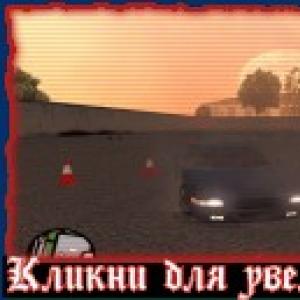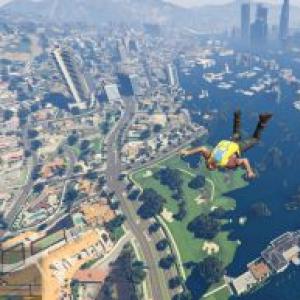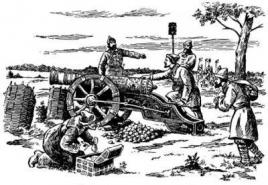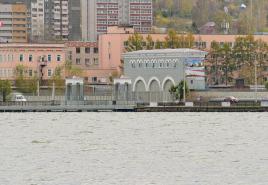Prince Oleg brief description. Biography of Prince Oleg briefly for children
The exact date of birth of Prince Oleg is not known. In Novgorod, Oleg began to reign in 879... After that, he was able to kill the rulers of Kiev, Dir and Askold. And since 892 he already fully ruled Kiev. Since he reigned in Kiev, he accordingly moved the capital there. Some chroniclers believe that it was from that time that the formation of the Old Russian state began.
Russian Prince Prophetic Oleg was the constant leader of campaigns. One of the most fateful was his campaign against Byzantium. Since then, he received his nickname "Prophetic", which meant "seeing the future."
Death of Prince Oleg from a horse (snake).
The prince died in 912. Legend has it that the Magi predicted death from their own horse to Prince Oleg. The horse was taken away by order of the prince. Four years later, Oleg remembered the prediction, laughed at him and wanted to check the horse's remains. Oleg put his foot on the horse's skull and said the phrase "Should I be afraid of him?" However, in the horse's skull there was a poisonous snake, which inflicted a fatal bite on the prince.
The reign of Prince Oleg.
Foreign policy of Prince Oleg. Hike to Byzantium.
Thanks to his strength, Prince Oleg was able to annex such tribes as the northerners, Drevlyans, Krivichi, Polyana, Radimichi to his lands (to Kievan Rus). All these peoples, before joining the Kievan Rus, paid tribute to the Khazars.
In 907, the legendary campaign against Byzantium took place, which acquired new turn in foreign policy Prince Oleg. Equipped with decent weapons at the time, Oleg set out to capture Byzantium. The emperor of Byzantium could not resist the army of the prophetic Oleg and allowed him to plunder Constantinople.
Oleg went on a campaign on ships, but being a seer, he ordered the wheels to be fastened to the ships. Thanks to this, he was able to freely penetrate the capital of Byzantium by land and with flying sails. After the capture of Byzantium, Oleg ordered to pay tribute for each of his soldiers and for all Russian cities. The Greeks had to agree. He also demanded free trade for Russian merchants, that is, without duty obligations.
Domestic policy of Prince Oleg.
Since Prince Oleg was distinguished by his aggressive activities and during his reign many cities were conquered, his goal was to strengthen these new borders. Defensive fortresses were built.
The internal policy of the prince was mainly aimed at collecting constant taxes from the tribes he captured. He regularly traveled around his fiefdom and collected tribute.
PLAN
Brief biography of Prince Oleg
The story of the Prophetic Oleg in the chronicle of Nestor "The Tale of Bygone Years"
The image of Prince Oleg in the poem by Alexander Pushkin "The Song of the Prophetic Oleg"
Bibliography
Brief biography of Prince Oleg
Prince Oleg (? - 912)
First Kiev prince from the Rurik family. The chronicle says that Rurik, dying, transferred power to his relative, Oleg, since the son of Rurik, Igor was very small at that time. For three years Oleg reigned in Novgorod, and then, having recruited an army from the Varangians and the tribes of Chudi, Ilmen Slavs, Mary, Vesi, Krivichi, he moved south.
Oleg cunningly took possession of Kiev, killing Askold and Dir, who reigned there, and made it his capital, saying: "This will be the mother of Russian cities." By uniting the Slavic tribes of the north and south, Oleg created a powerful state - Kievan Rus. A well-known legend in the annals is associated with the death of Oleg, which served as a motive for the poem by A.S. Pushkin's "Song of the Prophetic Oleg". According to the chronicler's account, Oleg reigned for 33 years, from 879 (the year of Rurik's death) to 912.
The story of the Prophetic Oleg in the chronicle of Nestor "The Tale of Bygone Years"
The Prophetic Oleg, an ancient Russian prince who lived in the 9th-10th centuries, is reported in ancient chronicles, his name is mentioned in historical documents, but most of the information about his life and work has come down to us in the form of folk tales, in which real events are closely intertwined with legendary ones.
The story of the Prophetic Oleg in Nestor's chronicle collection "The Tale of Bygone Years" also has a legendary character. The Tale of Bygone Years is the earliest surviving chronicle collection. Belongs to the beginning of the XII century. This set is known as part of a number of chronicle collections preserved in lists, of which the best and oldest are Laurentian 1377 and Ipatiev 20s of the 15th century. The chronicle has absorbed a large number of materials from legends, stories, legends, oral poetic legends about various historical figures and events.
Nestor calls Oleg a relative of the Novgorod prince Rurik. But from other sources it is known that Oleg had no family ties with the prince, but was his governor and reached a high position only thanks to his personal merits.
He possessed an outstanding talent for a military leader, and his wisdom and foresight were so great that they seemed supernatural. Contemporaries called Oleg the Prophet. The lucky warrior-prince is nicknamed "prophetic", that is. a wizard (although the Christian chronicler did not fail to emphasize that the nickname was given to Oleg by the pagans, "people of trash and non-voices"), but he also cannot escape his fate. Under the year 912, the chronicle places a poetic tradition associated, obviously, with "Olga's grave", which "is ... to this day." This legend has a complete plot, which is revealed in a laconic dramatic narration. It clearly expresses the idea of the power of fate, which none of the mortals, and even the "prophetic" prince, can not escape.
It is possible that the folk memory of the Prophetic Oleg was reflected in the image of the epic prince-wizard Volga: Volga wanted a lot of wisdom: to walk like a pike-fish in the deep seas, fly as a bird-falcon under the shell, as a gray wolf to prowl in clean fields.
Rurik died in 879. Dying, he bequeathed reign to Oleg and left his young son Igor in his care.
For three years Oleg ruled in Novgorod, and then, having gathered a strong squad and taking Igor with him, he set off to conquer new lands.
At that time, vast areas of the Russian land were inhabited by numerous tribes. The chronicle names more than ten Slavic tribes: Vyatichi, Krivichi, Polyan, Northerner, Radimich and others. Ugro-Finnish tribes coexisted with them: Chud, all, Merya, Muroma. Russia had no clear boundaries and did not know uniform laws. The Kiev prince exercised his power only in a few key points that controlled trade routes. He also collected tribute from the subordinate Slavic and non-Slavic tribes. The payment of this tribute, as well as the very fact of recognizing the supreme power of Kiev, constituted at that time the entire essence of state power.
The collected tribute (primarily furs) had to be sold in neighboring countries - the Caliphate and Byzantium. Russia received considerable profit from this trade and was vitally interested in its development. The annual influx of thousands of barbarian merchants into the capital had many inconveniences for the Byzantines. Hence the desire to limit and restrict Russian trade. For Russia, trade was a matter of state, therefore, the response to the actions of the Byzantine authorities was given at the state level.
Oleg with his army moved from north to south by water... We sailed along the Ilmen Lake, then along the Lovati River and the Western Dvina, and then, dragging the boats, along the Dnieper.
On the way, Oleg conquered the Krivichi city of Smolensk and the Severiansk Lyubech, leaving his governors there.
Finally, Oleg arrived in the rich and fertile lands of the meadows - and saw on the high bank of the Dnieper a large, beautiful city... That city was called Kiev. Two princes reigned in Kiev - Askold and Dir. Both of them were from Novgorod and once, like Oleg, served Prince Rurik.
Oleg decided to seize Kiev, but seeing that the city was well fortified, he used not force, but cunning.
He left most of his army behind, and himself, with young Igor and a small squad, on one boat approached the very walls of Kiev and sent a messenger to Askold and Dir: "We are Varangian merchants, we are carrying a lot of good goods. Let the Kiev princes come. look - maybe what they buy. "
Askold and Dir believed that a peaceful merchant caravan had arrived in Kiev, and went ashore without any protection.
Oleg ordered the soldiers who were with him for the time being to lie down at the bottom of the boat. When the Kiev princes came close, he got up to meet them and said: "You are not a princely family, but I am a prince, and Igor, the son of Rurik, is with me. I, and not you, should rule here!" He gave a sign to his soldiers - and they instantly hacked down Askold and Dir with their swords.
Karamzin, very highly assessing the activities of Oleg, this act of his unconditionally condemned: "The general barbarism of these times does not excuse the murder of the cruel and insidious."
Oleg entered the city victorious and commanded: "Let Kiev be the mother of Russian cities!" Having established himself on the Kiev throne, he continued the work of conquering neighboring lands and conquering the tribes inhabiting them. Oleg subdued the Drevlyans, northerners, Radimichs and imposed a tribute on them. A huge territory was under his rule, on which he founded many cities. This is how the great Kievan principality - Kievan Rus was formed.
When Igor became an adult, Oleg chose his wife - Olga (according to some sources, she was the daughter of Oleg himself), but he did not concede the principality.
"In the year 6415 (that is, 907 according to modern calculation)," the chronicler writes, "Oleg went against the Greeks, leaving Igor in Kiev."
Equipping two thousand ships and collecting a huge cavalry army, Oleg set out on a campaign. The ships sailed along the Dnieper, heading for the Black Sea (it was then called the Pontic, or Russian), and the horsemen walked along the coast.
Having reached the sea, the cavalry also boarded the ships, and Oleg's army rushed to Constantinople.
"And Oleg came to Constantinople (Constantinople)." Here appeared the capital of Byzantium - its white fortress walls, golden domes of temples.
The Byzantine emperor Leo the Wise, seeing ships with an innumerable army, ordered to hastily lock the harbor. Strong iron chains were stretched across the bay, blocking the way for Oleg's ships.
Oleg had to turn aside and disembark at some distance from the city.
Oleg's warriors ravaged the Tsargrad suburbs, burned houses and churches, killed civilians and threw them into the sea. The chronicler, justifying the cruelty of Oleg's warriors, explains: "This is usually done in war."
But Oleg could not take Constantinople itself - the chains reliably protected the city from invasion from the sea. Then he ordered his soldiers to make wheels, put the ships pulled ashore on them and raise the sails.
A fair wind blew - and the ships rushed to the city over land, as if by sea.
“The Greeks, seeing this, were frightened and said through the ambassadors to Oleg:“ Do not destroy the city, we will give you any tribute you want ”.
Having finished the war with a profitable peace, Oleg returned to Kiev with glory. This campaign created him immense popularity in the eyes of not only Russia, but also the Slavs, who called their prince the Prophet. A modern historian, however, should be very careful about the above stories of the Russian chronicle, since the Greek chronicles do not mention a single word about this great campaign.
Karamzin considers this episode to be legendary: “Maybe he (Oleg) ordered the soldiers to drag ships along the shore to the harbor in order to approach the city walls; ".
However, later historians acknowledge the validity of this episode. D.S. Likhachev writes: "In the conditions of river navigation in the north of Russia, ships and boats put on wheels were a common phenomenon." Dragging "of ships on wheels or rollers took place in Russia (...) in the watersheds of rivers (...). The Kiev chronicler tells about the movement of Oleg's ships on dry land as something amazing. This is understandable - there were no "drags" near Kiev. However, for the "Novgorodian" Oleg and his Novgorod squad, this was nothing unusual. "
So it was or otherwise, but the frightened Byzantines admitted themselves defeated and agreed to pay Oleg the tribute he wished. Oleg demanded 12 hryvnia for each pair of oars on his two thousand ships, as well as a tribute for Russian cities - Kiev, Chernigov, Polotsk, Rostov and others.
As a sign of victory, Oleg strengthened his shield on the gates of Constantinople. An agreement of peace and permanent friendship was concluded between Russia and Byzantium. The Byzantine Christians swore to observe this treaty by the holy cross, and Oleg and his warriors swore by the Slavic gods Perun and Veles.
After the death of Rurik, his relative, Oleg, as the eldest in the family, who was also the guardian of his young son, began to rule the country. Having become a prince, Oleg entrusted management to the boyar (the boyars - the upper stratum of society - were vassals of the prince and were obliged to serve in his army, and were senior members of the squad), and with the army moved south, took possession of Smolensk and sailed to the Dnieper. Approaching the Kiev mountains, he hid the squad in boats and sent to tell Askold and Dir that the Varangian merchants wanted to see their fellow countrymen. When Askold and Dir came, Oleg took Igor in his arms and said: "You are not princes and not a princely family, but the son of Rurik!" At these words, the wars jumped out of the boats and killed Askold and Dir. Oleg remained to reign in Kiev, saying: "Be this city the mother of Russian cities." So in 882 Kiev became the capital of the Russian state, and Russia became Kiev.
In the future, Oleg conquered the Drevlyans, the northerners, the Radimichs. Oleg managed to unite in his hands all the main cities along the great path. This was his first goal. Thus, under his hand gathered all the main tribes of the Russian Slavs, except for the outlying ones, and all the most important Russian cities. Kiev became the focus of a large state and liberated the Russian tribes from the Khazar dependence. Throwing off the Khazar yoke, Oleg tried to strengthen his country with fortresses from the eastern nomads (both Khazars and Pechenegs) and built cities along the border of the steppe. Hoping for more valuable booty, he made a trip to Byzantium on thousands of boats. Having passed the Black Sea and the Bosphorus (or the Constantinople Strait), the Russians stopped at Constantinople, went ashore and began to kill people and burn the surrounding houses and churches. Then they pulled the boats ashore, put them on wheels, pulled on the sails, and, when a fair wind blew, set off on a dry road to the city. The Greeks got scared, sent Oleg food and wine and asked for peace. Oleg did not accept any food or wine, guessing that they were poisonous, but he agreed to the world. The emperor gave him a lot of gold, expensive fabrics and, moreover, allowed Russian merchants to travel freely to Constantinople for trade.
The activity of Oleg was in fact of exceptional importance: he created a large state from the disunited cities and tribes, brought the Slavs out of the Khazars' subordination and arranged, through treaties, trade relations between Russia and Byzantium; in a word, he was the creator of Russian - Slavic independence and strength.
The capture of Kiev by Oleg opens a new page in Russian history - the period of the so-called Kiev state, or Kievan Rus. Unlike the previous South Russian formations of the state type, in more early periods located on the Don and in the Azov region, the Dnieper river route - "Varangian to the Greeks" - now becomes the main geographical axis of the Russian state. For Oleg, however, Kiev was only the first, albeit the most important, point on the way to the South. The southern Dnieper region remained in the hands of the Magyars for a number of years, and it would take about thirty years after the conquest of Kiev for Oleg to begin his first campaign against Constantinople. Nevertheless, Kiev remained a strong point in all his subsequent campaigns to the south, and therefore we consider the date of Oleg's arrival in Kiev an important milestone.
The Romanovs under Ivan the Terrible
In December 1546, Ivan Vasilyevich, in a conversation with the metropolitan, expressed two wishes: first, to get married, not as a grand duke, but as a tsar; secondly to marry. Both desires surprised the metropolitan and the boyars: no one had yet dared to marry a tsar, not a grand duke, although Ivan III and Vasily III in some cases called themselves sovereigns and tsars. ...
October Revolution. Formation of the Bolshevik statehood
Revolutionary democracy, represented by the Petrograd Soviet, demanded the transfer of power into the hands of the "revolutionary proletariat and peasantry." The composition of the presidium of the Soviet changed: the new one included the Bolsheviks and left-wing social revolutionaries. Bronstein (Trotsky) was elected chairman. In early October, the Bolsheviks were in the majority ...
Rivalry between Moscow and the Tver principality
The wealthy Tver was famous for its trade, and the Tver prince, by the will of the Horde Khan, was made senior over other Russian princes. Ivan Danilovich did not want to put up with this and was waiting for an opportunity to earn mercy and trust in the Horde and get the coveted label. In 1327, such a case presented itself. In Tver, flared up ...
In 879, leaving his young son Igor, the Novgorod prince Rurik died. The board was taken over by Oleg the Prophet, Prince of Novgorod from 879 and Grand Duke Kiev from 882. In an effort to expand his possessions, the prince gathered a fairly strong army. It included the Krivichi, Ilmenian Slavs and representatives of the Finnish tribes. Moving south, Oleg annexed the cities of Smolensk and Lyubech to his possessions. However, the plans of the young ruler were more ambitious. Having surrendered power in the conquered cities to the people loyal to him, the warlike prince moved to Kiev. Oleg's campaign to Kiev was crowned with success. In 882 the city was captured, and its rulers Askold and Dir were killed. Oleg ascended the Kiev throne. The same year is considered a date.
The reign of Prince Oleg in Kiev began with the strengthening of the city walls and defensive structures. The borders of Kievan Rus were also fortified by small fortresses ("outposts"), where the warriors carried out constant service. In 883-885. the prince undertook several successful campaigns. The Slavic tribes who settled along the banks of the Dnieper, the Radimichi who lived on the banks of the Dniester, Bug, Sozh, Drevlyans and northerners were subordinated. By order of Oleg, cities were built in the occupied lands. The conquered tribes were required to pay taxes. Actually, the whole internal policy of Oleg, like other princes of that time, was reduced to collecting taxes.
Oleg's foreign policy was successful. The most important event began a campaign against Byzantium in 907, the Prince gathered for this campaign a huge army at that time (according to some sources, up to 80 thousand people). Byzantium, despite the defensive cunning of the Greeks, was captured, the suburbs were plundered. The campaign resulted in a rich tribute, as well as trade benefits for Russian merchants. Five years later, peace with Byzantium was confirmed by the conclusion of a written agreement. It was after this campaign that the great Kiev prince Oleg, the founder of the state of Kievan Rus, began to be called the Prophet (i.e., the sorcerer).
Prince Oleg, one of greatest rulers Rus, died in 912. His death is shrouded in legends. According to one of them, the most famous, Oleg asked about his death the sorcerer he met on the road. He predicted the death of the prince from his beloved war horse. The prince never mounted this horse again, but ordered his entourage to take care of him. Many years later, Oleg wished to see the bones of the horse, deciding that the sorcerer was mistaken. He stepped on the skull, and a poisonous snake crawled out of it and stung the prince. After his death, Oleg was buried in Kiev. There is another version of the death of the prince, according to which the warlike Oleg died in battle.
The biography of Oleg, who became the first prince, whose life and deeds are confirmed by the annals, became the source of many legends and literary works... One of them - "The Song of the Prophetic Oleg" - belongs to the pen of A.S. Pushkin.
Alexander Pushkin created many works, different in style and genre. The poet was interested in the history of Russia, studied documents and folklore sources on this topic. As a result, he writes an amazing ballad "". It focuses on the heroic past, and also raises important philosophical questions, such as, for example, is a person subject to his fate?
The central images are Prince Oleg and. First - the main character, a brave Kiev prince. The second is the embodiment of the poet, from no one independent person-creator.
The image of Oleg has a historical prototype. But when creating it, the author used not only reliable historical sources, but also legends. Oleg is known for his successful campaigns and military exploits. It was not only a matter of the prince's courage, but also of his wisdom, his ability to predict the course of events in the war. For this feature, they nicknamed Oleg the Prophet. When the army of the prince began to defeat the Greeks, they decided to poison the enemy. They brought him a poisoned treat. However, Oleg did not accept him, as he guessed their insidious plan.
But, despite the fact that Oleg was a wise strategist, he knew how to predict events in the war, but he could not foresee his fate. For this, a second important hero, a sorcerer, is introduced into the ballad. It is he who says that Oleg's fate will be decided by his faithful horse. And this is very symbolic, something that will not destroy the Grand Duke dangerous enemy, but the most faithful comrade. The magician not only tells Oleg about his fate, but also gives him a capacious characterization as a brave and invincible prince. This person speaks the truth without fear of punishment. After all, a sorcerer is the image of a freedom-loving poet. Oleg does not want to believe that the horse can harm him. However, he sends his faithful friend away from him.
Is the prince doing the right thing by believing in the prophecy? In fact, he himself refuses to take fate into his own hands. Perhaps the author wants to show us that you can't just shut yourself off from fate. There are only two options: either follow fate, or actively resist it. But do not try to get away from her. The prince tried to do so, and he failed.
The prince reveals himself on the good side in love for his faithful comrade in arms, the horse. He always looked after him, trusted him as the best ally. And even when he sent him away from himself, believing in the prophecy, he still did not forget about him.
The artistic image of Oleg, created by Pushkin, is much more human than in the annals. Indeed, according to the chronicle, Oleg, having learned about his fate, abandons the horse and does not even want to see him again.
Oleg's image is an image fearless warrior, a wise ruler, who was called prophetic because he easily predicted the course of military events, but could not figure out his own fate.







